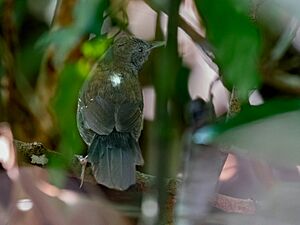Black-throated antbird facts for kids
Quick facts for kids Black-throated antbird |
|
|---|---|
 |
|
| A male at Manaus, Amazonas state, Brazil. | |
| Conservation status | |
| Scientific classification | |
| Genus: |
Myrmophylax
|
| Species: |
atrothorax
|
 |
|
| Synonyms | |
|
Myrmeciza atrothorax |
|
The black-throated antbird (Myrmophylax atrothorax) is a small bird that lives in the forests of South America. It belongs to a group of birds called "typical antbirds." You can find this bird in countries like Bolivia, Brazil, Colombia, Ecuador, French Guiana, Guyana, Peru, Suriname, and Venezuela.
Contents
About the Black-throated Antbird's Name
The black-throated antbird got its scientific name a long time ago. A French scientist named Georges-Louis Leclerc, Comte de Buffon first described it in 1779. Later, in 1783, a Dutch naturalist named Pieter Boddaert gave it the scientific name Formicarius attothorax. The spelling was later corrected to atrothorax.
The bird's scientific name, Myrmophylax atrothorax, tells us a bit about it. The first part, Myrmophylax, comes from ancient Greek words meaning "ant" and "watcher." This suggests the bird might watch or follow ants. The second part, atrothorax, comes from Latin words meaning "black" and "breast." This describes the bird's black throat and chest.
This bird used to be in a different group of birds, but scientists studied its DNA. They found that the old group wasn't quite right. So, they moved the black-throated antbird to its own special group, Myrmophylax. It is the only bird in this group.
There are five slightly different types, or subspecies, of the black-throated antbird:
- M. a. metae
- M. a. atrothorax
- M. a. tenebrosa
- M. a. maynana
- M. a. melanura
What the Black-throated Antbird Looks Like
The black-throated antbird is about 13 to 14 cm (5.1 to 5.5 in) long. That's about the length of a small ruler. It weighs around 14 to 18 g (0.49 to 0.63 oz), which is very light.
Male birds of the most common type (M. a. atrothorax) have a gray face. Their head and back are a dark yellowish-brown. Their tail is grayish-black. Their wings are also yellowish-brown with black and white tips on some feathers. The center of their throat and chest is black, and the rest of their belly is gray.
Female birds look a bit different. They have a dull reddish-yellow-brown head and back. Their wings are dark brown with light buff tips. Their chin and upper throat are white. The rest of their belly is a reddish-brown color. Both male and female birds have gray legs.
Some of the other subspecies have small differences in their colors. For example, some males might have white spots on their black chest. Others might have darker or lighter upper parts.
Where the Black-throated Antbird Lives and Its Home
The black-throated antbird lives in many different places across South America. Each subspecies is found in a specific area:
- M. a. metae: Central Colombia.
- M. a. atrothorax: Southern Venezuela, eastern Colombia, the Guianas, and northern Brazil.
- M. a. tenebrosa: Eastern Ecuador, northeastern Peru, and northern Brazil.
- M. a. maynana: North-central Peru.
- M. a. melanura: Eastern Peru, Bolivia, and western and central Brazil.
These birds like to live in different kinds of forests, especially near water. They can be found in lowland forests, swampy areas along rivers, and places where forests are regrowing. In some areas, they live in wet parts of savanna woodlands. In Peru and Bolivia, they often live near tall cane plants and bamboo. No matter where they are, they usually stay close to the ground in the lower parts of the forest.
Black-throated Antbird Behavior
Movement
Scientists believe that the black-throated antbird stays in the same area all year round. It does not migrate to different places.
Feeding Habits
The black-throated antbird mainly eats small creatures like insects and spiders. It usually looks for food alone, in pairs, or with its family. It almost never joins large groups of different bird species looking for food.
This bird mostly finds its food within 1 m (3 ft) of the ground. Sometimes, it might go as high as 3 m (10 ft). It finds prey by picking it off leaves, branches, and vines. It also looks for food in dead leaves on the ground. It rarely follows swarms of army ants, which many other antbirds do.
Reproduction and Life Cycle
We don't know everything about when and how the black-throated antbird nests. It seems to depend on where they live. One nest found was shaped like a cup. It was made of dead leaves and lined with soft fibers. This nest was placed low over water in a clump of grass-like plants. It held one baby bird, and both parents were feeding it.
Vocalization
The black-throated antbird has a special song. It's a series of 4 to 8 very sharp "chee" notes. The song starts with a stuttering "tutu" sound, then gets a little louder and higher in pitch. It sounds like "tutu-chee-cheé- -".
Its calls include a sharp, downward-sloping note. It also makes a mix of short "chit" notes and longer, flat whistling sounds.
Status and Conservation
The IUCN (International Union for Conservation of Nature) says the black-throated antbird is a species of "Least Concern." This means it is not currently in danger of disappearing. It lives in a very large area, and even though we don't know exactly how many there are, its population seems to be stable.
There are no big threats to this bird right now. It is quite common in most places where it lives. It can also live in different types of habitats, including regrowing forests and forest edges. This helps it survive better than some other birds that need very specific types of forests. It also lives in protected areas in many countries.


